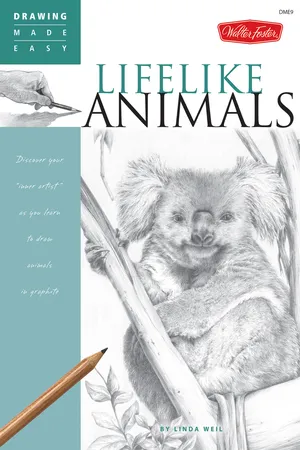
eBook - ePub
Lifelike Animals
Discover your ?inner artist? as you learn to draw animals in graphite
- 64 pages
- English
- ePUB (mobile friendly)
- Available on iOS & Android
eBook - ePub
About this book
Learn to draw remarkably realistic animals step by step
Inside this beautiful, comprehensive book, accomplished artist Linda Weil shows readers how to capture the personality and character of a range of animals, from a magnificent elephant to a cuddly koala to a group of mischievous meerkats. The 64-page book introduces readers to tools and materials, as well as basic drawing and shading techniques, before delving into a collection of stunning step-by-step projects. Aspiring artists will discover information on animal anatomy, sketching from life, drawing young animals, and depicting animals in action. With a wealth of inspiring images and invaluable information, this book is a "must-have" for every animal-loving artist.
Frequently asked questions
Yes, you can cancel anytime from the Subscription tab in your account settings on the Perlego website. Your subscription will stay active until the end of your current billing period. Learn how to cancel your subscription.
At the moment all of our mobile-responsive ePub books are available to download via the app. Most of our PDFs are also available to download and we're working on making the final remaining ones downloadable now. Learn more here.
Perlego offers two plans: Essential and Complete
- Essential is ideal for learners and professionals who enjoy exploring a wide range of subjects. Access the Essential Library with 800,000+ trusted titles and best-sellers across business, personal growth, and the humanities. Includes unlimited reading time and Standard Read Aloud voice.
- Complete: Perfect for advanced learners and researchers needing full, unrestricted access. Unlock 1.4M+ books across hundreds of subjects, including academic and specialized titles. The Complete Plan also includes advanced features like Premium Read Aloud and Research Assistant.
We are an online textbook subscription service, where you can get access to an entire online library for less than the price of a single book per month. With over 1 million books across 1000+ topics, we’ve got you covered! Learn more here.
Look out for the read-aloud symbol on your next book to see if you can listen to it. The read-aloud tool reads text aloud for you, highlighting the text as it is being read. You can pause it, speed it up and slow it down. Learn more here.
Yes! You can use the Perlego app on both iOS or Android devices to read anytime, anywhere — even offline. Perfect for commutes or when you’re on the go.
Please note we cannot support devices running on iOS 13 and Android 7 or earlier. Learn more about using the app.
Please note we cannot support devices running on iOS 13 and Android 7 or earlier. Learn more about using the app.
Yes, you can access Lifelike Animals by Linda Weil in PDF and/or ePUB format, as well as other popular books in Kunst & Kunst Allgemein. We have over one million books available in our catalogue for you to explore.
Information
DRAWING FROM LIFE
To draw animals realistically, it is important to observe them and sketch them from life. By watching how the animal moves and relates to its environment and other creatures, you can better portray the animal’s character and appearance. Drawing an animal in the wild is difficult and possibly dangerous, so zoos, wildlife parks, animal sanctuaries, and rescue centers are the preferred source of subjects. If none of these are available to you, you can resort to a video, but this is a very poor second to seeing, hearing, and smelling the living creature.
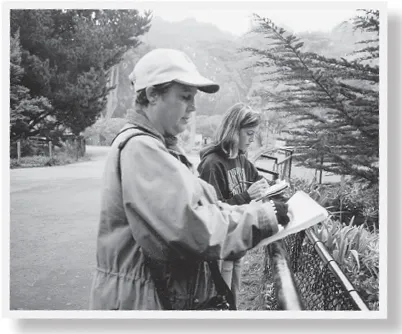
Drawing on Location Author Linda Weil (left) sketches with her niece (right) at the San Francisco Zoo.
What to Take
Your kit can be as simple or as complex as you wish and are capable of carrying. Here’s a list of the items I always take when drawing on location:
1. A range of pencils (start with at least an HB and a 2B)
2. Sketchbook
3. Appropriate clothing and a hat
4. Insect repellent
5. Sunscreen
6. Water bottle
7. Pencil sharpener
8. Camera (if you’re drawing an animal you’ve never seen before or don’t have many references of)
9. Something to sit on (if you’re going to be in front of one animal for an extended period)
What to Do
1. Be prepared for uncooperative animals. It seems inevitable that whenever I go to study one particular animal, that is the ONE animal that is hidden all day or not on display. If I am after a particular animal, I have learned to always call first to ensure that the animal will at least be on display—whether it performs is a matter of luck. But there is nothing more frustrating than turning up on the one day of the year that the animal is getting its annual medical checkup and isn’t on view!
2. Be aware of the animal’s habits. Many animals are most active in the early morning or evening and will sleep out of sight in the afternoon. Is the animal nocturnal? If so, check with the keeper to find out the best time to view it, or arrange a private visit. Find out its feeding times and try to be there then.
3. Be patient. If the animal isn’t moving or visible when you arrive, wait a while. Animals operate on their own schedules, not yours, so be patient and you will be rewarded.
4. Be flexible. Patience didn’t work? Why not check out the animal next door? I guarantee you will see something interesting elsewhere if you keep your eyes open.
5. Expect an audience. People are always curious about what you are doing, especially children. If you are shy or hesitant about being watched, try to find a good spot that is discrete and out of the way. Some people will show great interest and ask questions about what you are doing. This is a wonderful opportunity for you to tell them about your artwork. If you are confident enough, give them your business card; you could be pleasantly surprised with a commission opportunity!
6. Be polite. Animals can be sensitive and shy, so don’t shout or tap on the glass or wave your arms to attract the animal’s attention. This can frighten the animal and make you look foolish, especially when the animal disdainfully ignores you! Also, don’t hog the best viewing spots. Share these with the public, especially children. Do all you can to encourage their interest and allow them to see what you have been watching so carefully.
Simplifying with Shapes
When you’re just starting out, drawing animals from life can be very confusing. Often your first time drawing from life results in something that doesn’t look anything like the animal in front of you. Don’t be discouraged; you might just be drawing your preconceived notion of what the animal should look like instead of what it really looks like. The best way to avoid this is to make a deliberate effort not to draw the animal but, instead, to draw the shapes that compose the animal. By breaking down the animal into simple circles, ovals, squares, or triangles, you not only lessen the confusion, but you also make it easier to get the correct structure and proportions.
Below are several animal drawings that are made up of simplified shapes. As you can see, cylinders, circles, and ovals form the basic structure of each drawing. I often use this technique to begin a drawing. When you take your sketchbook out into the field and begin to draw, start with these simple shapes and lines. Work quickly and freely, and keep the drawing simple. Don’t be worried if the animal is moving; just start another drawing on the same or next page. An animal usually will pace and return to its previous position so you can continue where the first or second drawing left off. Fill your page with several different views and angles of the moving animal. Don’t fuss over small details; try to capture the overall form and feeling of the animal. Your aim is to take a quick “snapshot” in pencil.
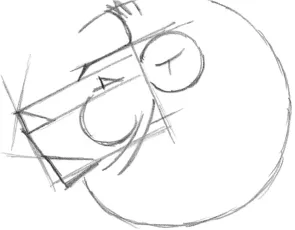
Lion
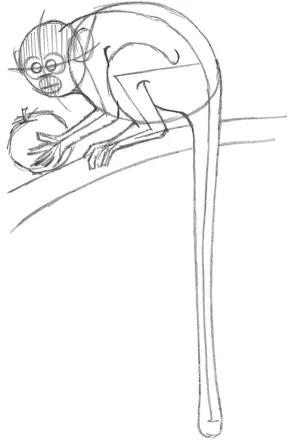
Squirrel monkey

Australian fur seal
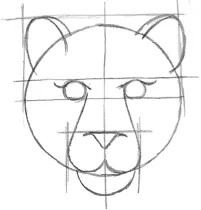
Sumatran tiger
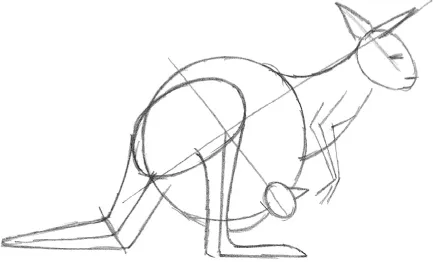
Black wallaby
Sketchbook Selections
I frequently visit the local zoo and wildlife sanctuary. Whenever I go, I take my camera and sketchbook along. Sometimes I get so enthralled with watching the animals that I may do only one or two drawings. My books are filled with incomplete studies. My sketchbooks are not meant to be “finished” art but studies and observations of animal forms and behaviors. I never come away without having learned something. Here is a selection of drawings from my sketchbook that were made using the techniques discussed on page 19.

Alpha Baboon The Alpha Baboon in a troop has the most wonderful coat of luxurious hair that is assiduously tended to by his harem of females. His eyes are deeply set and brooding, and he is a rather proud animal.

Pelican These preening birds have beautiful curves in their necks. I find it amazing that they can manipulate that huge beak so delicately to reach the most out-of-the way areas on their bodies.

Zebra This zebra was most obliging and stood still for several minutes. He too was enjoying the spring warmth.

Red Kangaroo Called the “Old Man of the Desert,” the kangaroo has a big, blocky head with large, upright ears and is heavily muscled around the shoulders and forearms. The kangaroo...
Table of contents
- Cover
- Title Page
- Contents
- Introduction
- Tools and Materials
- Getting Started
- Understanding Value
- Learning to “See”
- Drawing Accurately
- Perspective Basics
- Animal Anatomy
- Animal Textures
- Drawing From Life
- Composition
- Asian Elephant
- Australian Barking Owl
- Tiger Cub
- Koala
- Dingo
- Lion Profile
- Kangaroo
- Giraffes in a Landscape
- Zebra in Motion
- Group of Meerkats
- Closing Words
- Copyright Page